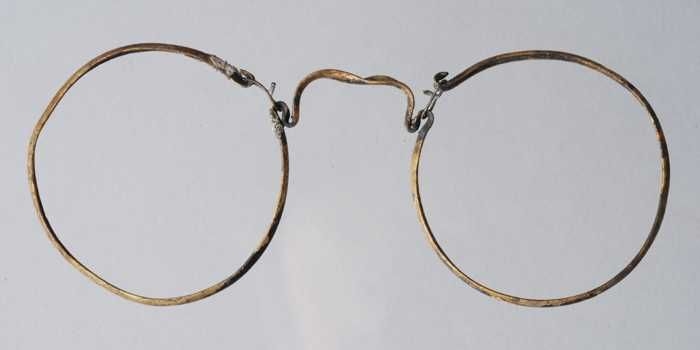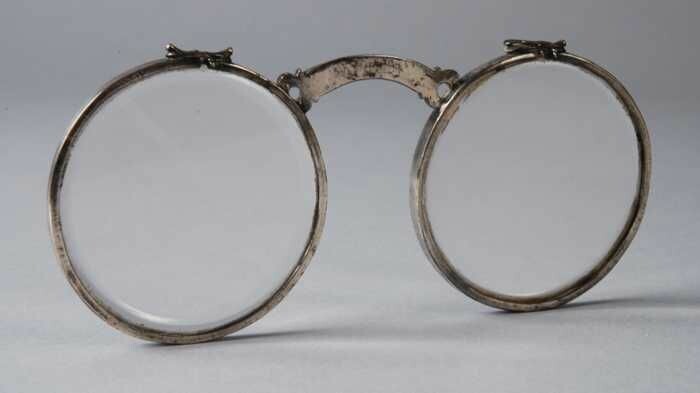A quick look at spectacles in the seventeenth century as they appear in inventories and accounts, and a few survivals.
An early mention of spectacles in England is in Thomas Hoccleve’s 1415 Address to Sir John Oldcastle where he writes “as a spectacle helpith feeble sighte, Whan a man on the book redith or writ.” Spectacles were fairly common by the end of the sixteenth century, when we have the description of the old miser in Thomas Lodge’s 1596 work Wits Miserie, whose “spectacles hang beating over his codpiece like a flag in the top of a maypole.”
Who owned spectacles?
Most of the references here are in the account books of middle aged gentry and nobility. Many appear in the 1620s and 1630s accounts of the Howards of Naworth Castle in Cumberland, where they were sometimes purchased several pair at a time, as in 1625 “for 6 pair of specktles and 2 duble cases and mending 2 pair and a come case.” (1 p. 231) In the 1640s and 1650s they appear among the expenses of Henry, Earl of Bath, in 1646 “2 pair of spectacles and a case for my Lord 6s” (2 p. 129), they are also purchased for people who were part of the Bath entourage, and not necessarily just the men, as we have in 1651, “for a case and 2 pair of spectacles for Mrs Herle 3s 6d” (2 p. 159). In 1635 another gentlewoman, Lucy Gobert has “spectacles and cases” in her inventory. (3 p. 53), and a widow, Anne Lloyd in Stratford in 1617 has “two pair spectacles 12d” (4 pp. 297-8). Tradesmen of a certain status also appear to have had spectacles, in 1638 John Smith, a Hampshire clothier, had spectacles in his inventory. (5)
 |
| Figure 1: Bow folding spectacles. Science Museum, London. CC BY 4.0 |
Who sold spectacles, and what did they cost to buy?
Spectacles appear in the inventories of various chapmen, mercers and grocers throughout the century, these appear to be cheaper than the ones owned by the gentry. In 1619 the chapman John Carrier of Aby, Lincs had spectacles in stock. (6 p. 62). In 1638 the grocer Edmund Daniell, in Hampshire, had a dozen pairs in stock at 3d a pair. (7) In 1668 Silvester Widmere, a Buckinghamshire mercer, has “2 dozen spectacles 7s,” so 3½d a pair.
As can be seen above, those spectacles purchased for the gentry, often are bought with a case. When bought without a case, those in the Naworth accounts range from 9d to 2s 6d. (1) Like today this range in prices may depend on what the frames were made from, though it is possible that the lenses also influence the price. In 1666 Samuel Pepys, on the advice of Lord Brouncker, purchased green spectacles, “to see whether they will help my eyes or no.” (8 p. 24 Dec 1666). These were not a new thing as Howard of Naworth had purchased a green pair in 1633. (1 p. 293)
What were the frames made from?
Horn was one of a range of options, as in figure 1, a pair of bow folding spectacles, from the second half of the seventeenth century. In 1626 Howard of Naworth paid 3d for “new horning a pair of spectacles.” (1 p. 234)
Wire was another option. As in figure 2, which is of copper wire curved in one piece and then tightened by twisting another piece of wire, this example was found in an archaeological context, and may therefore be closer to the cheaper type of spectacles. Somewhat more upmarket were silver frames, as in figure 3, a pair of spectacles which belonged to the Dutch politician Johan van Oldenbarnevelt (1547-1619).
 |
| Figure 2: Spectacles made of copper wire. Museum Rotterdam 32600. Public Domain |
In 1648 Lord Bath had the lenses changed in his frames paying “for changing my Lord's silver spectacles & putting the glasses in 8d.” (2 p. 140) In 1629 Howard of Naworth had paid “for setting one payre of spectacles in sillver for my Lord 2s 6d.” (1 p. 256). It is difficult to be sure whether they already had the lenses and the frames cost 2s 6d, or if the cost is for the lenses, most likely the former.
A new material was tortoise shell. In 1647 Lord Bath purchased a, “tortiose shell frame for my Lord's spectacles 1s 4d” Tortoiseshell was beginning to be used, as John Evelyn said of the port of Dieppe in 1644, “It abounds with workmen who make and sell curiosities of Ivory and Tortoise shells.” (9 p. 60)
 |
| Figure 3:Silver framed spectacles. Museum Rotterdam 51414. Public domain |
Cases
Spectacles were often purchased with cases. In 1665 the mercer Benjamin Marshall had in stock, “two dozen of spectacles and sixe cases 2s 6d” (10 p. 16). Cases survive in a range of materials including cardboard, leather, wood and metal. In 1633 Howard of Naworth purchased “4 payre of spectacles and two cases of tortoyse shell for my Lord “ together these items cost 11 shillings. Howard also purchased in 1629, spectacles with a gilded case, these worked out at half the price of the tortoiseshell. (1 p. 297 & 252) A top of the range spectacles case from the late seventeenth, with a pair of slightly later spectacles, are in the Victoria and Albert Museum, they have links to James II (figure 4). The case is of painted and gilded mother-of-pearl, and dates from the 1680s.The spectacles, which are from the first quarter of the eighteenth century, are tortoiseshell frames with a silver bridge.
 |
| Figure 4: Specactles and spectacles case. Victoria & Albert Museum, W.5 to B-1970 |
References
1. Ornsby, G. ed. Selections from the Household Books of the Lord William Howard of Naworth Castle. Publications of the Surtees Society. 1878, Vol. 68.
2. Gray, Todd. Devon Household Accounts 1627-59. Part 2 . Exeter : Devon and Cornwall Record Society, new series, vol. 39, 1996.
3. Earwaker, J.P. Lancashire and Cheshire wills and inventories 1572-1696. Manchester : Chetham Society, 1893.
4. Jones, J, ed. Stratford-upon-Avon Inventories,volume 1, 1538-1625. Stratford-upon-Avon : Dugdale Society , 2002.
5. Victoria County History: Hampshire: Basingstoke Probate Material 1631-40. . [Online] [Cited: 3 Jan 2022.] https://www.victoriacountyhistory.ac.uk/explore/sites/explore/files/explore_assets/2015/01/20/will_inventory_of_john_smith_clothier_hro_1638b-75.pdf.
6. Spufford, Margaret. The great reclothing of rural England: petty chapman and their wares in the seventeenth century. London : Hambledon Press, 1984.
7. Victoria County History: Hampshire: Basingstoke Probate Material 1631-40. [Online] [Cited: 3 Jan 2022.] https://www.victoriacountyhistory.ac.uk/explore/sites/explore/files/explore_assets/2015/01/20/will_inventory_of_edmund_daniell_snr_grocer_hro_1638a-041.pdf.
8. Pepys, Samuel. Diary. [Online] [Cited: 10 October 2021.] https://www.pepysdiary.com/diary.
9. Evelyn, John. Diary and Correspondence of John Evelyn. London : Colburn, 1854.
10. Johnston, J. A. Probate inventories of Lincoln citizens 1661-1714. Woodbridge : Boydell, for the Lincoln Record Society, 1991.
No comments:
Post a Comment
Note: only a member of this blog may post a comment.